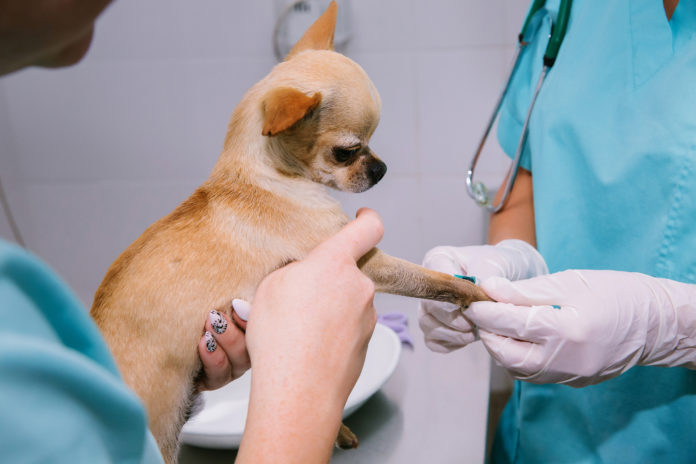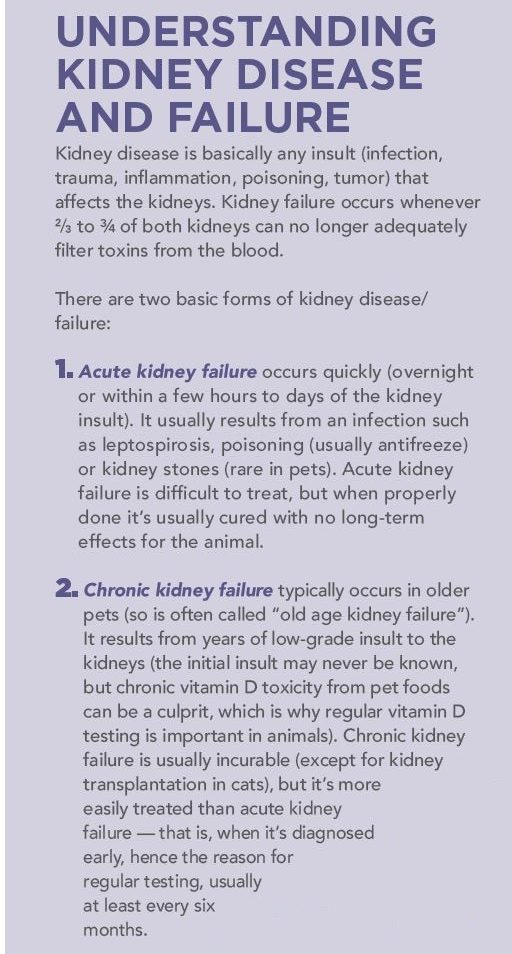Testing for kidney disease in your dog or cat

A large number of older dogs and cats develop kidney disease or failure. With correct diagnostic testing, the problem can be caught early enough for more successful treatment.
Kidney disease and failure is one of the most common disorders I see in dogs and cats. It’s extremely prevalent as animals age, especially in those eight years of age and up. While it can be fatal, kidney disease can usually be treated and even cured if caught early. Let’s look at the testing that allows for the early diagnosis of this frequently-seen health problem in dogs and cats.
Ways to test for kidney disease
Blood tests
- The BUN (blood urea nitrogen) is one of three blood tests for kidney function. It is a good screening test but not perfect, as it only elevates significantly if kidney function is destroyed by 60% to 70%. However, it is inexpensive to run and part of most blood panels. BUN is also affected by diet, exercise and muscle mass, so results can be skewed due to non-kidney factors; increased results must be interpreted in light of these factors.
- Creatinine refers to an amino acid constituent of muscle protein. Like BUN, this test also doesn’t show significantly-elevated results until kidney function has deteriorated by 60% to 70%. It is also affected by diet, exercise and muscle mass, though not as much as BUN is. Blood profiles that incorporate only these two tests can accurately diagnose kidney disease once the disease has progressed to a later stage, but are not so good at diagnosing very early disease.
- Therefore, a third test called SDMA (symmetric dimethylarginine), which tests for the amino acid arginine, may be incorporated into the blood panel. SDMA levels elevate very early in the course of kidney disease, anywhere from 12 to 36 months before BUN and creatinine elevate (reflecting only 25% kidney damage versus 60% to 70%).
Other blood tests that can help diagnose pets with kidney failure include measuring blood levels of phosphorus and calcium. Phosphorus in particular tells us about the severity of kidney issues since it elevates when the kidneys are severely damaged. Pets with elevated blood phosphorus levels and elevated levels of the kidney enzymes just mentioned are much harder to treat and have a poorer prognosis.
Infectious disease testing
Other than bacterial infections such as E. coli or Proteus, which move from the bladder to the kidneys, the most common bacterial infection of the kidneys in animals (especially dogs) is leptospirosis. It results from contact with infected urine, typically of rodents and other animals.
It is important to consider this a cause of kidney disease for two reasons. First, early diagnosis and treatment is essential — the longer you wait to diagnose and treat the greater the chance the animal will die. Secondly, this infection is easily transmitted to other animals and people. Leptospirosis titers, which can take one to two weeks to be reported, are useful but can be skewed by prior leptospirosis vaccination.
Urine testing
While a urinalysis is typically done when you visit your own doctor, most veterinarians unfortunately do not routinely do this important test. This can occur because it’s harder to collect urine from animals, or because doctors don’t appreciate how much information we glean from urine testing. Regardless, this is an important adjunct to blood testing.
The urinalysis can complement results noted in blood tests, as well as give us additional information the blood testing may not provide. For example, urine testing shows if glucose or ketones are present (indicating diabetes mellitus). We can also detect early protein (albumin) loss through the kidneys in a urinalysis. This isn’t detected in a blood profile; excessive urine protein loss is very common in dogs and requires early treatment to prevent more serious problems.
Examining the urine microscopically also tells us about the possible presence of inflammation, infection, bleeding, cancer and bladder stones. If you can collect urine from your dog or cat, it should be analyzed at least every six months.
Urine culture
A urine culture tells us two important things: if an infection of the kidneys or bladder is present, and which bacterium is causing the infection. Additionally, if bacteria are seen, the cultured bacteria are examined for susceptibility for antibiotic responsiveness.
I often see animals with “bladder infections/UTIs” diagnosed by other doctors, but who don’t truly have infections. The (mis)diagnosis occurs because it was made based only on seeing white blood cells in a urinalysis (which indicates inflammation but not necessarily infection). While a urinalysis may indicate a possible infection, only a culture can determine if the infection is actually present and if antibiotics are needed. In order to reduce the need for antibiotics and prevent further antibiotic resistance (many bladder issues are easily treated without them), a culture should be done before these drugs are used. Exceptions include animals that are bleeding heavily in their urine, or those with urinary blockages where an underlying infection is a likely cause.
Note: if a pet is treated for a UTI with antibiotics, based on a culture, a follow-up culture should be done in one to two weeks after finishing the antibiotics to make sure the bacteria are killed and to prevent a worse infection due to incorrect treatment.
Radiography
This test involves small amounts of X-ray radiation to allow the doctor to look inside your dog or cat’s body. For animals with kidney issues, radiography may allow detection of stones or tumors. While radiographs are an important part of testing for possible kidney disease, and may allow identification of other problems, ultrasonography typically reveals better information about kidney status in animals.
Ultrasonography
Any time I see an unexplained illness that is not diagnosed with the other tests I’ve discussed, or if my screening tests for inflammation and cancer (TK, CRP, CRA) are elevated. I find that ultrasonography is necessary to look for the causes of these abnormal tests.
Ultrasound exams are safe as they use sound waves rather than radiation. They can usually be done on an awake pet without the need for sedation, unless he is fractious. Because ultrasounds image tissue in a different way from radiographs, it is typically important to do both (usually starting with radiographs since they are easier and less expensive to do).
As you can see, a variety of tests are important in evaluating your pet’s urinary system. Work with your veterinarian to do whatever testing is needed to maximize the chances of an early and correct diagnosis. Ongoing monitoring via tests is especially important in a holistic treatment approach, in order to catch changes early and alter treatment if needed.





